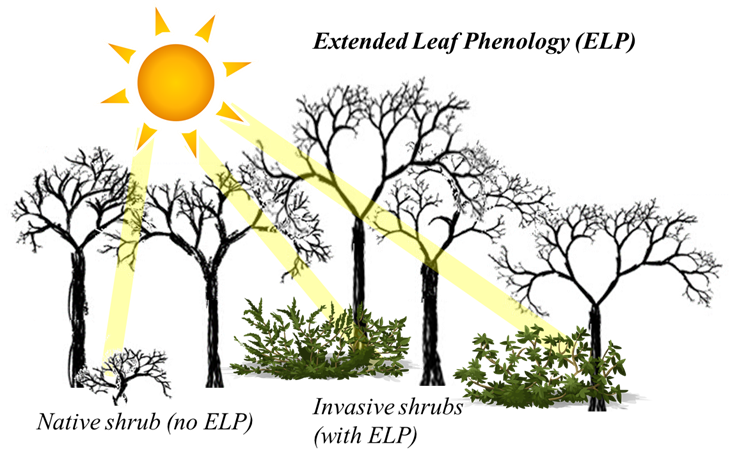This campaign has ended, read more about the results below!
PROJECT BACKGROUND
Invasive shrubs are becoming increasingly common in eastern forests. These shrubs are top competitors for native shrubs - they can break bud earlier in the spring and hold onto leaves longer in the fall. This phenomenon is called Extended Leaf Phenology (ELP), and allows these early-leafing invaders to take advantage of the greater amount of light reaching the forest floor in early spring.
ELP of these shrubs can create shading on the forest floor at times when native herbs, tree seedlings, insects, reptiles and more depend on that greater sunlight.
Shady Invaders was a project created by researchers at Penn State University to explore the timing of leaves on invasive and native shrubs. The goal of the project was to start to quantify ELP on a regional scale so that we can understand how or if increased shading is actually impacting deciduous forest ecosystems.
We have ended the phenology observation phase of the Shady Invaders campaign. However, we still encourage observations of these species in Nature's Notebook!
See what we learned from this campaign
Learn more about what defines an invasive species
The campaign included observations on the following invasive species:
- Japanese barberry (Berberis thunbergii)
- Amur honeysuckle (Lonicera maackii)
- multiflora rose (Rosa multiflora)
- burningbush (Euonymus alatus)
- privet (Ligustrum sp.)
- Morrow's honeysuckle (Lonicera morrowii)*
- Tatarian honeysuckle (Lonicera tatarica)*
And the following native species:
- spicebush (Lindera benzoin)
- mapleleaf viburnum (Viburnum acerifolium)
- flowering dogwood (Cornus florida)
- gray dogwood (Cornus racemosa)
- black haw (Viburnum prunifolium)
- alternateleaf dogwood (Cornus alternifolia)
- southern arrowwood (Viburnum dentatum)
- hobble-bush (Viburnum lantanoides)
*Note that these two species hybridize commonly and form a separate species, Lonicera x bella.
RESULTS FROM THE SHADY INVADERS CAMPAIGN
See published results from this campaign.
The map below shows the sites where observers reported data on invasive and native shrubs. While the campaign focused on the eastern U.S., we had a few sites reporting on these species in the west, including one site in Canada. Many sites reported data in all three years of the campaign (indicated by dark green on the map).
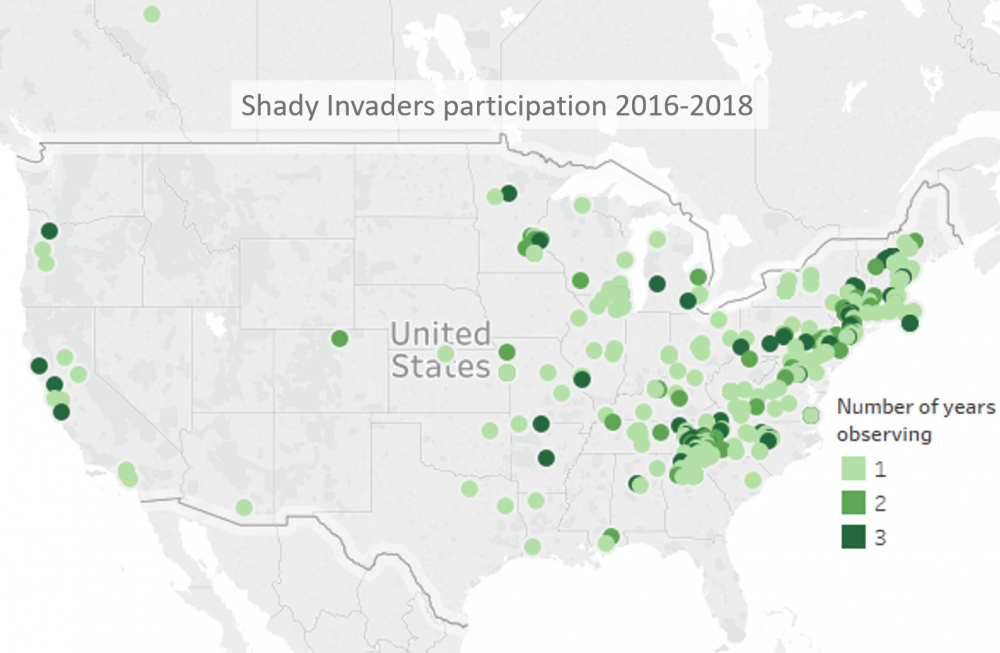
The year with the highest number of observers was 2017, with 417 observers, followed by 2018 with 388 observers reporting. All 878 observers submitted a total of 375,635 observations over the course of the campaign.
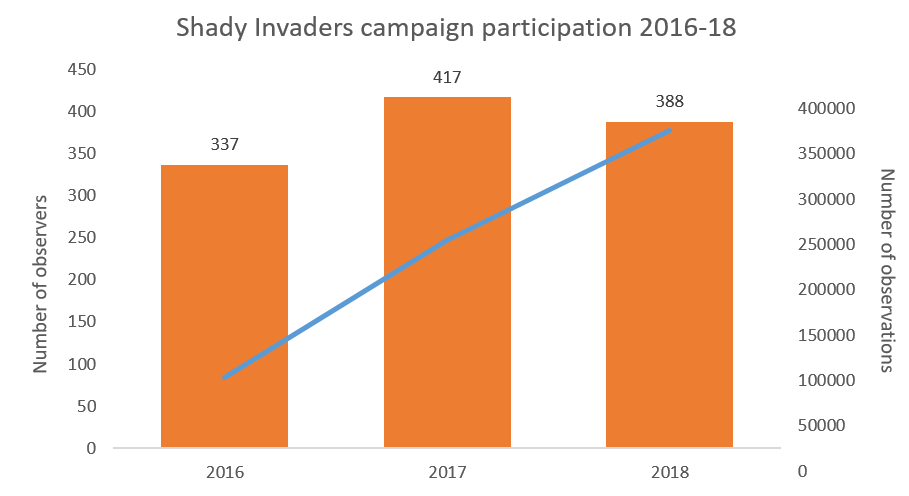
Your data captured 1,605 onsets of breaking leaf buds, and 1,585 end dates for leaves.
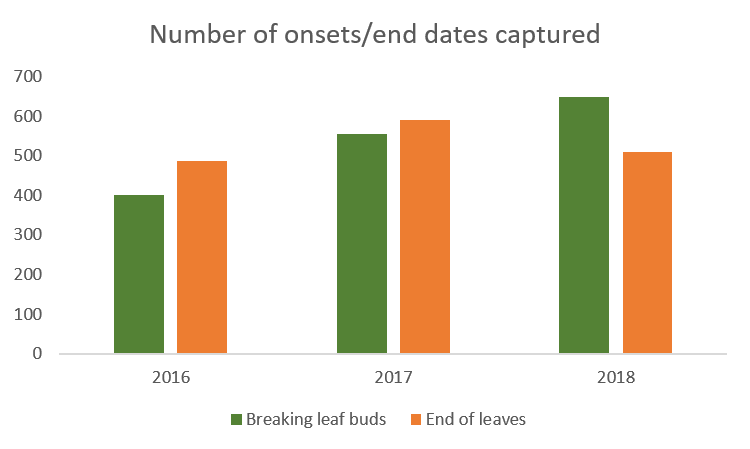
Researcher Erynn Maynard analyzed your data to answer the question of whether invasive shrubs have Extended Leaf Phenology, and what environmental variables contribute to the difference.
She found that invasive shrubs leaf out earlier than native shrubs, but this effect diminishes at northern latitudes. This is likely because at the most northern latitudes, cold spring temperatures end up limiting both native and invasive plants. Invasive shrubs are better able to take advantage of warmer spring temperatures that occur at lower latitudes. Given predictions of warmer spring temperatures across the East due to climate change, we could see an increased advantage of invasive species across latitudes in the future.
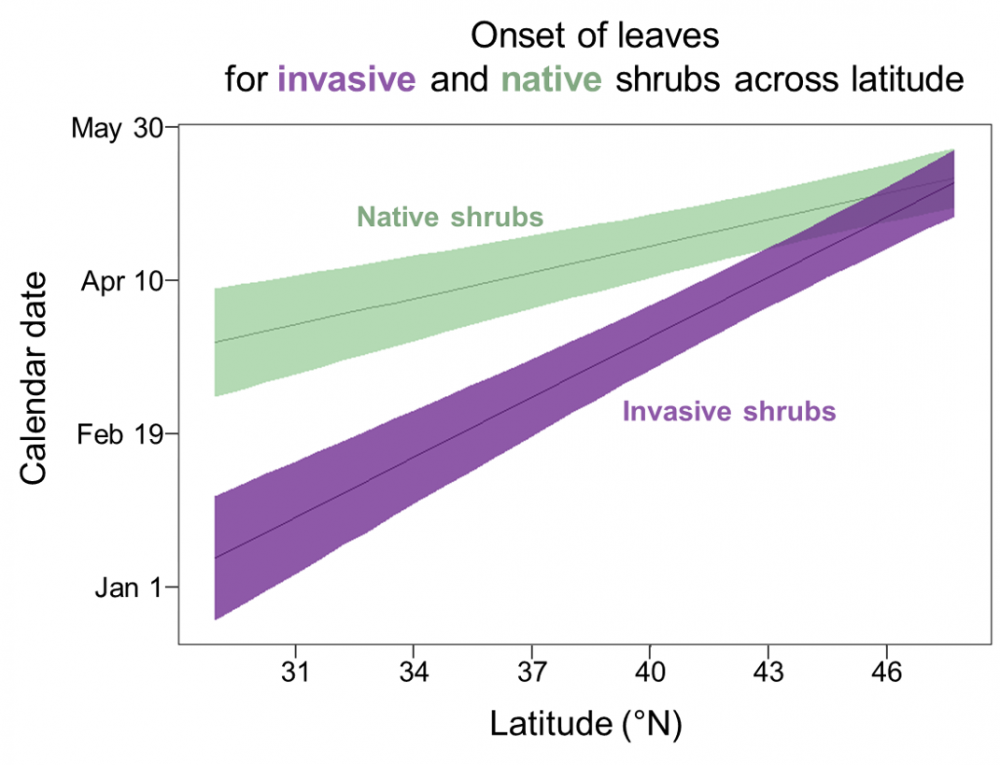
Figure: Relationships and 95% credible intervals (shaded regions around lines) showing fit between onset date and latitude. The model's R squared is 0.74, meaning that 74% of the variation in the data is explained by the model.
To look at the differences between species, Erynn estimated the onset of leaves by species for the mean latitude of the dataset. The species follow the pattern of invasive species leafing out earlier than native shrubs, with the exception of burningbush. Why is this species different? Burningbush has green branches, which may mean that this species doesn't need leaves to take photosynthetic advantage of extra sun in the spring.
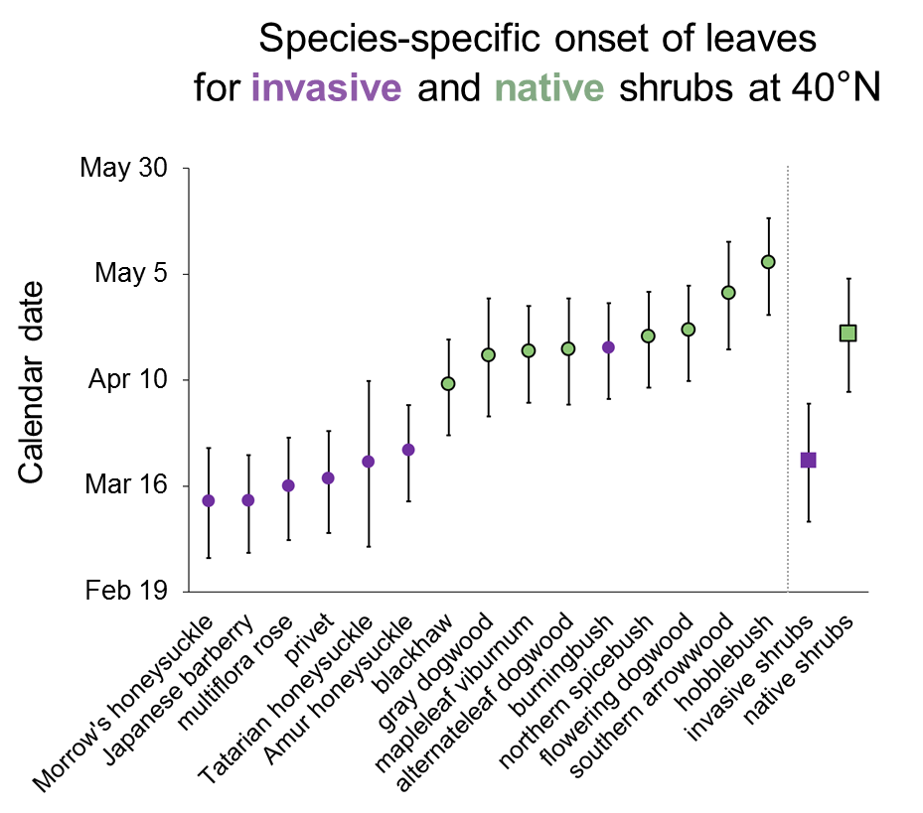
Figure: Modeled onset of leaves by species for the mean latitude of the dataset, 40 degrees N. Mean onset for invasive and native shrubs is also shown on the right.
Erynn also looked at which environmental variables have the most impact on shrubs, and found that both native and invasive shrubs have an earlier onset of leaves with warmer average spring temperatures. Invasive shrubs also respond to warmer bud chilling days, greater spring precipitation, and higher elevation.
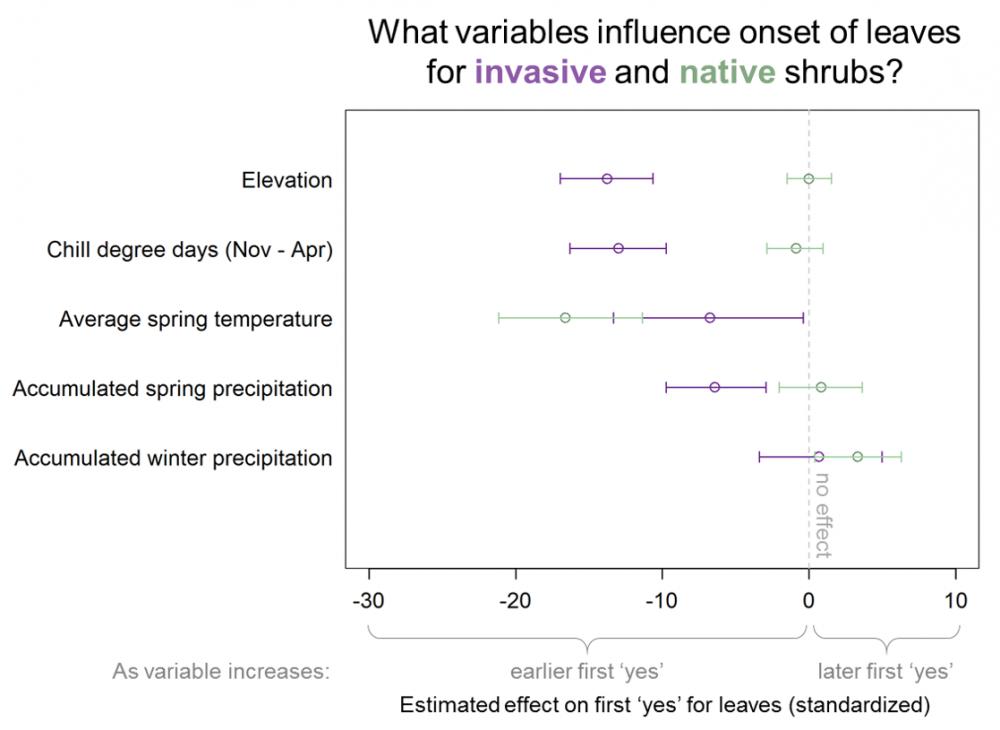
Figure: Environmental variables influencing whether leaves appear earlier or later on native and invasive shrubs.
While data on fall phenology are still coming in, Erynn has done some preliminary summaries of your data on end of the leaves phenophase, fall color, and falling leaves. Invasive shrubs have later average dates for all three phenophases, showing they hold onto their leaves longer than native shrubs.
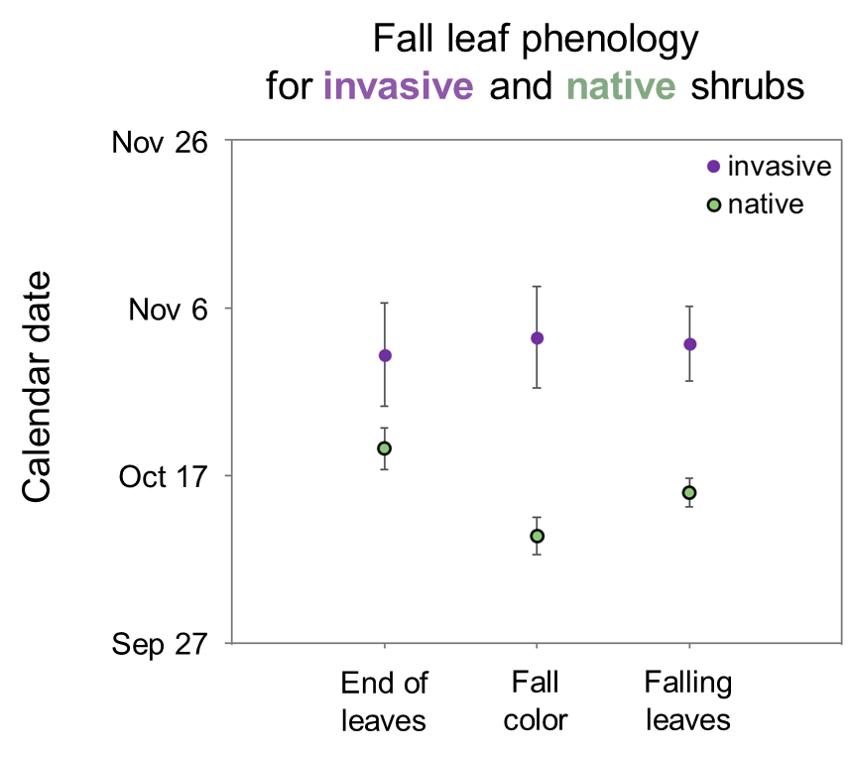
Figure: Average end of leaves, onset of fall color, and onset of falling leaves for native (n = 270) and invasive shrubs (n = 55), 2016-2018.
What makes a species invasive?
Non-native species are those that are found outside of their historic range, generally as a result of human activities. Invasive species are those non-native species that thrive outside of their historical range with a demonstrated detriment to the invaded ecosystem, economics or human health. Not all species that are non-native become invasive. In fact, very few individuals survive outside of their native range, because the conditions are different from what they have adapted to over many generations.
While invasive species are generally the unintentional product of increased global transportation, many invasive plants continue to be intentionally introduced. Invasive shrubs are an increasingly prevalent component of eastern forests. (Shrubs are generally defined as woody plants with multiple stems arising at or near the ground and are generally shorter and have smaller stem diameters than trees.) Studies estimate that 82% of the 235 invasive woody species in the United States, and 62% of invasive woody species globally were introduced intentionally for horticultural purposes.
